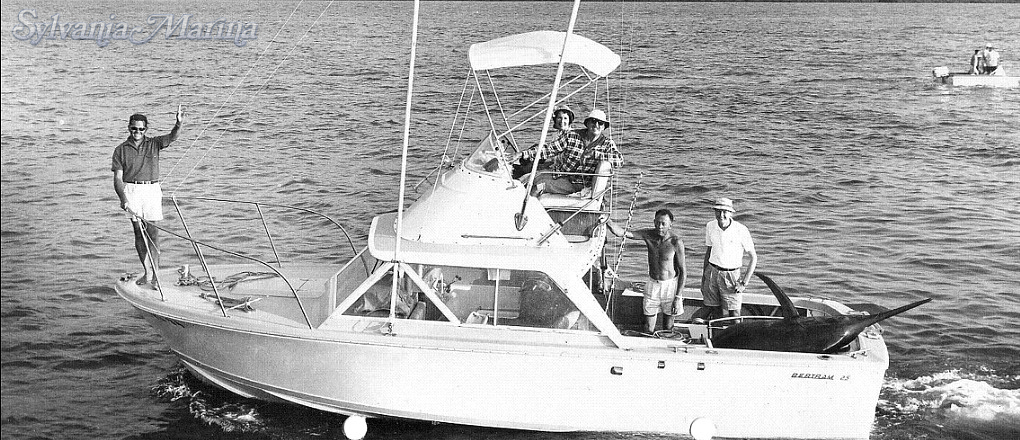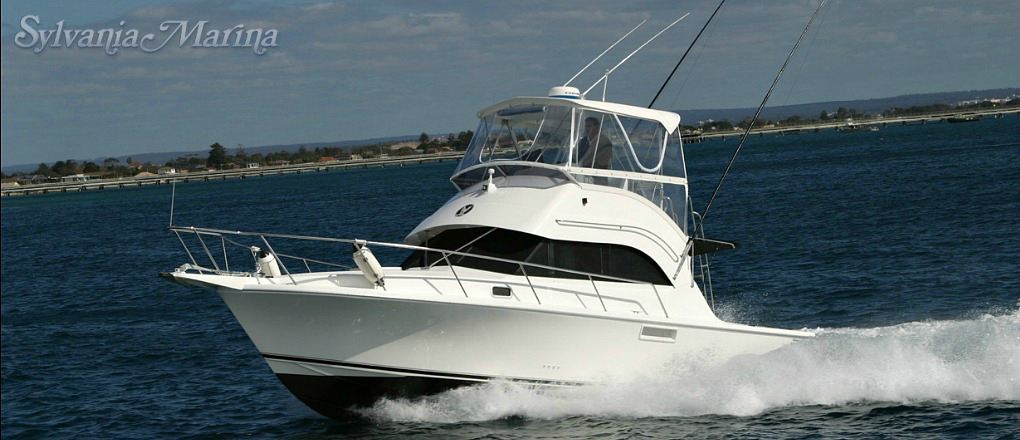2005 Caribbean 32 Boat Review

Caribbean cruisers are like floating homes with decent backyards. They’re based on sound foundations, down-to-earth and practical design, with little pretence. You get a lot of real estate for your money. You look at them and think, yes, this works; I could buy this boat and raise my recreationally-minded family aboard.
But of all the Caribbeans, the new 32 seems to be the home-away-from-home capturing the most imagination now. It’s priced in the realms of affordability, capable of accommodating a family, and has a cockpit big enough to tangle with a whopper or play with the kids outdoors.
Released at the Sydney International Boat Show, the 32 is a timely boat, too. Expect meagre fuel bills from the twin 220hp Cummins diesel inboards, which are the only mechanical motors that International Marine, the makers of Caribbean, ever fit. More a bungalow than a bayside penthouse, the 32 doesn’t have too much glitz. But as it sits on the water it’s plain nice to look at and very well proportioned. The 32 can also be viewed as a great platform on which to build your dream boat; which is exactly what Sylvania Marina was doing with yet another work-in-progress when I arrived.
THE BIG MAKEOVER
Sylvania Marine’s Nathan Ghosn, who has built a reputation for turning these humble factory-supplied boats into fully-fledged fishing boats with more comforts, was mid-stream on one of his signature makeovers when we arrived keen to put the new 32 through its paces.
To start with, the cruiser does come with a rather excellent hardtop as standard. The top, which looks as though it’s borrowed from the Caribbean 26, shades an impressively obliging flybridge virtually as big as the Caribbean 35 and w-a-y bigger and better than the 28.
Among the key add-ons for this fishing and family man were an invertor, separate battery bank and extra house batteries for power away from the dock; battery charger; an entertainment system including Xbox (games); deep-water two-kW Furuno depth sounder, 24nm radar and autopilot; cockpit and bridge carpets; clears; outrigger poles, rocket launcher and rodholders; plumbing for the bait tank; awning and cockpit fridge; stainless-steel barbecue and cutting board.
As far as the hull is concerned there’s nothing left wanting, but nothing more to see than fibreglass and resin. Internal finishes are best described as honest and what you get with the engineering is time-proven, although there is plenty of scope for improving the electrical and plumbing systems.
BRIDGE & DECK
The standard hardtop isn’t high and it required this 180cm driver to stoop ever so slightly. But it does look in proportion and, I’m told, that will help keep the weight down and help maintain a low centre of gravity. There is also non-skid on the hardtop so you can clean it if needs be, and a radio box built in. A vertical support for the top doubles as a handrail, but the stainless-steel struts forward might be changed on the Caribbean 32 that Ghosn plans on campaigning for himself.
Seating on the big bridge includes a transverse lounge for two to port and an L-shaped lounge forward of the helm console. This lounge is big enough for a quick nap with your legs hanging over and resting on the floor. There is storage under these seats, behind the helm console and in the flybridge brow.
The twin helm seats offer a pretty clear view of the bow and a great view back down. An awning was added, but you could still see the cockpit corners and, I imagine, the rod tip when fighting a big fish.
The carbon dash panels had twin sets of Cummins engine gauges, a Clarion remote, Furuno flush-mounted 12in screen and a 10in unit on a bracket mounted on top of the dash.
The ladder leading to the bridge was to be fitted with Starboard or plastic tread steps but the moulded steps in the cockpit leading to the sidedecks are fine as they are. With cabin rails, toerails and non-skid under foot, the passage forward was good. The bowrail needs an intermediate wire, but at least the foredeck is nice and flat, equipped with two fender baskets and foot controls for the windlass to complement the dash control.
The 6.4sqm cockpit is, says expert Ghosn, big enough to swing a gamechair. But he is an accomplished shark angler and for most of us stand-up tackle would be just fine. Leaning into the gunwales, the boat seemed to offer good toe space and thigh support for locking horns with a frisky fish.
The transom door is outward opening so as not to reduce the footprint of the cockpit, there are hawse pipes in the corners, a hot/cold handheld shower, cockpit spotlights, little sidepockets for mooring lines, and a 12V/240V fridge under the flybridge ladder.
The 855lt of fuel is aft and the lazarette between it and the engine room has enough storage room to carry a tender and foot pump. A custom sink unit to starboard would be a worthwhile addition in the cockpit.
ENGINEERING
The engine room is accessed through a hatch in the floor. Ghosn had the boat’s extra batteries mounted on the centreline and I noted sea strainers and fuel filters aft, the oil dipsticks on the centreline, and coolant overflow bottles forward.
A hot-water service is supplied, with the modest 180lt of water carried forward. I would have thought dripless seals would be standard on the shafts.
The props were four-bladers and the rest of the running gear is bronze. There are gate valves on all through-hull fittings. Though the engine room isn’t huge, you can remove the floor – or rather the mechanic can remove it – if there are more serious problems. I was wondering how to top up the oil and header tank for the cooling system and, voila, found small hatches in the saloon floor for this very purpose.
The built-in GRP holding tank isn’t easy to empty overboard. A button on the dash and/or circuit breaker is better than having to climb into the bilge. I don’t buy the argument that kiddies can too easily dump the tank, any more than they can too easily start the motors.
INDOOR ARRANGEMENT
The interior lacked refinement in a boating market that is increasingly demanding, but the fundamentals are in place to create a homely boat with some imagination and a few bucks needed to dress the insides. The centre sliding saloon door opens to reveal a two-person settee to starboard with drawers below. With the backrest removed, the settee makes a handy berth.
There is a U-shaped settee around a fixed timber dinette opposite that can seat three or four people. Both are raised on mounting boxes that make room for the Cummins engines below.
The boat needed more pelmets and the vinyl on the lounges is a bit passé, but the overall impression is that of an honest craft. In fact, the boat’s modesty will appeal to many buyers. I guess easy-clean moulded ceiling liner, toffee-coloured curtains and off-white upholstery are pretty timeless.
The saloon has opening side windows, as with all Caribbeans.
A lower helm version may or may not become available, but in this case the space to starboard behind the windscreen was used to mount a Xion 12V/240V television and Xbox game unit. Nearby was a very basic AC/DC control panel with separate switch for the hot-water service and shorepower trip. The CD player was positioned here, too.
With the invertor fitted, the compact galley to port is all you will need for a few days away from the dock. The small U-shaped space has moulded Granicoat counters with fiddles, a sink, recessed bin, a few drawers and a locker big enough to stow appliances. The boat comes with a microwave (which was running through an an aftermarket invertor) plus a spirit stove and a 55lt Engel 12V/240V.
It is possible to fit a four-kVA generator in the engine room, add air-conditioning, an electric stove and a few extra 240V power points, but the $22,000 for these luxuries will price this boat close to a Caribbean 35 – and that’s not the 32’s charter, which is to be an entry-level family fisher.
PLENTY OF BEDS
The kid’s cabin to port has wide bunks that aren’t quite long enough for me to stretch my legs – I’m guessing they are 175cm long – and there are three drawers, under-bed storage and an opening porthole with screen.
The head opposite, which you step up to and therefore has reduced headroom of about 175cm, is one big moulded space fitted with a shower stall and door, electric loo, moulded sink and hatch.
The master cabin up front has a really comfortable offset double bed with a small dressing seat alongside, plus a hanging locker, drawer unit, nice reading lights and a hatch. The door hits the bed, but it’s a small price to pay for such an accommodating space. I was genuinely surprised to find two cabins, and the layout makes the 32 a great family rig.
OFF TO SEA
The Cummins 220B motors are inline six-cylinder models with turbocharging but no aftercooling. While purely mechanical, they seemed only mildly smoky and moderately noisy. They did exhibit a good turn of speed and, without trim tabs and a full load of water and fuel, the Caribbean 32 rode in fine form.
Though the bow was slightly higher than one might want when attacking head seas, the hull rode smoothly and was dry in quite challenging conditions. Vision and comfort were both excellent when seated. I found the stereo remote and some rock-and-roll to match that which we had between Botany Heads.
At 1280rpm, the boat has a nice wake for trolling for marlin and it doesn’t labour at all climbing to low planing speed of 13.3kt at 1750rpm. Low cruise was clocked at 18kt at 2000rpm and this seemed to be the right speed for the sea.
The boat really slots into the cruising groove at 2200rpm and 22kt, and it travels at 25–26kt at maximum continuous revs of 2400rpm. At 2660rpm, top speed of 27.7kt was recorded, which is on par with most modern fully-laden flybridge boats.
If you were to say the twin 220hp diesel motors consume 60lt/h at 2200rpm, which is a bit more than published by Cummins, then you will have a safe working range of 300nm at cruise speed of 22kt. That’s efficient boating and means that nearby ports are very much on the radar.
I derived almost as much enjoyment watching the Caribbean 32 stride out across Botany Bay as I did driving the boat. It’s well-proportioned and, moreover, incredibly manoeuvrable. Ghosn believes it is without a doubt the most nimble Caribbean in the fleet. Look out fish.
The Caribbean 32 is also good buying and, when you consider its features, it’s a tempting proposition for a family of four. It’s not a McMansion, a modern apartment on water, nor is it a caravan. Think of it as a double-brick holiday house by the sea with a balcony from which you can cast a line.
HIGHS
- Big cockpit and twin cabins
- Priced well
- Perfect proportions and sweet lines
- Smooth-riding hull
- Well-known brand with good resale value
LOWS
- Very basic standard boat
- Lacks engine room bilge pump and high-water alarm
- Lacks dripless seals
- Lacks intermediate bowrail wire
- Holding tanks difficult to empty
- A bit noisy at certain speeds
- Interior could do with some polish
|
**Review written October 2005







Connect With Us